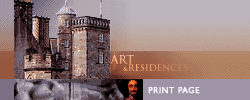|
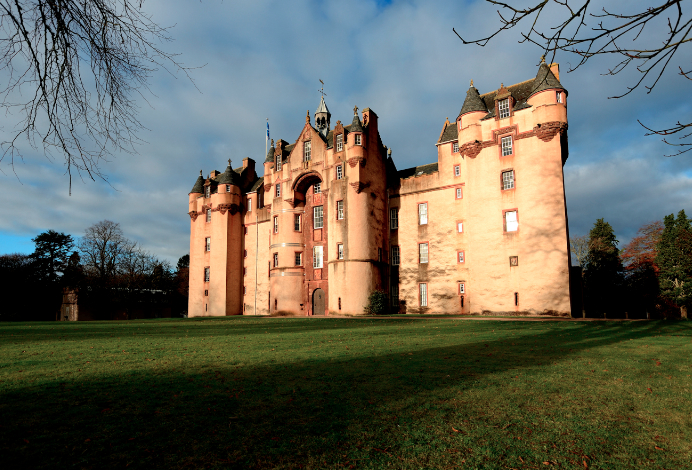 'Magnae Nobilitatis
Domini' 'Magnae Nobilitatis
Domini'
The Gallery of Seton
Residences
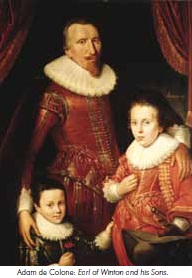 Seton, spelt in "The Muses'
Welcome" as Sea-towne and signifying "the dwelling by
the sea" and which referred originally to the family's
principal lands at Staithes circa 1066, the patronymic
Scottish Estate stands on a picturesque plateau in a recess
of the shores of Cockenzie and Port Seton in East Lothian,
high above the bays with it's flowing brooklet and
surrounded by ancient trees, and was long the residence of
the Head of Family of Seton. Seton, spelt in "The Muses'
Welcome" as Sea-towne and signifying "the dwelling by
the sea" and which referred originally to the family's
principal lands at Staithes circa 1066, the patronymic
Scottish Estate stands on a picturesque plateau in a recess
of the shores of Cockenzie and Port Seton in East Lothian,
high above the bays with it's flowing brooklet and
surrounded by ancient trees, and was long the residence of
the Head of Family of Seton.
According
to tradition, it was customary for the Earls of Wintoun once a
year to ‘ride the marches’ of their estates, which were so
extensive that a whole day, from sunrise to sunset, was required
to ride in state round the boundaries of their lands. On these
occasions the head of the house was always accompanied by a large
retinue of friends and retainers, mounted on gaily caparisoned
horses, the charger of the chief being arrayed in cloth of silk
adorned with gold tassels. The festivities which followed this
ceremonial lasted several days.
This Palace as it was
commonly called, was a strong, extensive, turreted building
much ornamented after the fashion of the 16th century,
though some parts were much older and improved upon during
the 17th century and with various inner and outer courtyards
and a magnificent walled garden known for it's first and
finest fruits. It was strong enough to afford defence
against repeated English invaders looking to seize the
capital, and later it's final defense against a party of the
rebellious Highlanders of 1715, but was left largely
abandoned following the 5th Earl's forfeiture and severely
damaged about 30 years hence during the rebellion of 1745,
and was falling into ruins.
It, having been destroyed
and cleared away in 1789-90, leaving only the northern block
from the rear and some barrel-vaults around the old inner
courtyard, the whole of which was used by the Architect
Robert Adam and re-worked as it stands now, as Seton Castle.
Within the walls however, still stands the Collegiate Church
of Seton, a view of which is engraved in Sir Walter Scott's
Provincial Antiquities of Scotland. The lands adjoining long
belonging to the Earl of Wemyss and March.
The
family, originally Carolingian and of the Royal lineage of
Charlemagne and
re-seated in the north country, owed its first
Royal-elevation in Scotland to the famous union of Sir
Christopher Seton with the sister of King Robert Bruce.
Always loyal knights serving the Royal House were the first
created Lords of Parliament and became the legendary
Lord's Seton. The Seton Palace was a favorite resort of
Queen Mary, and it was visited often by her in her royal progresses.
It was her first halting-place when she and Darnley made their
escape from Holyrood after the murder of Rizzio.
She was
entertained there by Lord Seton in 1567, and on that occasion she
and Bothwell won a match in shooting at the butts against Lords
Seton and Huntly. The forfeit was a dinner, which the losers had
to provide in an inn at Tranent, and was later the place of her
honeymoon following her 3rd marriage to the Earl of Bothwell.
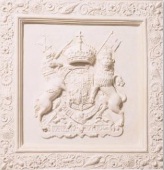 When her son was liberated from the Douglas captivity as a
youth, he was frequently at Seton, including his waiting on
his bride, the Princess Anne from Denmark, from the great
tower and passing his own honeymoon at Seton. The
Royal couple also entrusted the family in the rearing of
their son's Henry and Charles there, and Charles later
succeeding to become King Charles I. When her son was liberated from the Douglas captivity as a
youth, he was frequently at Seton, including his waiting on
his bride, the Princess Anne from Denmark, from the great
tower and passing his own honeymoon at Seton. The
Royal couple also entrusted the family in the rearing of
their son's Henry and Charles there, and Charles later
succeeding to become King Charles I.
With King James VI (and
later I of England) they acquired great favour, and before
the King's accession to the English throne his Majesty and
the Queen were frequently at Seton, where the 1st Earl of
Winton ever kept a very hospitable table, at which all
foreigners of quality were entertained on their visits to
Scotland. King James, who having made Robert eighth Lord
Seton, 1st Earl of Winton in 1600, created his brother
Alexander, Chancellor of the Realm of Scotland and 1st Earl
of Dunfermline in 1599, having entrusted him with the charge
of his second son, Charles Stuart, later to be King Charles
I. When King James VI and I came north and
revisited his native country in 1617, he spent his second
night in Scotland at Seton Palace and was superbly
entertained.
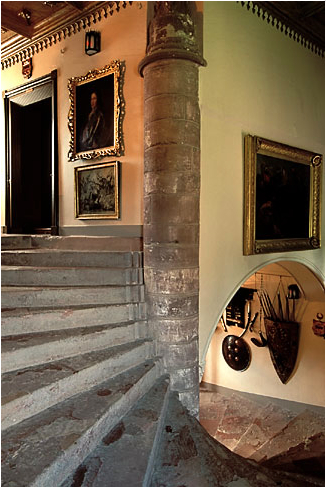 His Lordship the 1st Earl
of Winton died in 1603, and was buried at Seton on the 5th
of April, on the very day the King left Edinburgh for
England. His Majesty, we are told, was pleased to rest
himself at the south-west round of the orchard of Seton, on
the highway, till the funeral was over, that he might not
withdraw the noble company; and he said that he had lost a
good, faithful, and loyal subject. The deceased Nobleman's
eldest son Robert succeeded as second Earl of Winton, but in
1607 resigned the Earldom to his brother George who became
3rd Earl of Winton. His Lordship the 1st Earl
of Winton died in 1603, and was buried at Seton on the 5th
of April, on the very day the King left Edinburgh for
England. His Majesty, we are told, was pleased to rest
himself at the south-west round of the orchard of Seton, on
the highway, till the funeral was over, that he might not
withdraw the noble company; and he said that he had lost a
good, faithful, and loyal subject. The deceased Nobleman's
eldest son Robert succeeded as second Earl of Winton, but in
1607 resigned the Earldom to his brother George who became
3rd Earl of Winton.
The third Earl, who was now
the host of his Sovereign, lived honourably and kept a great
house at Seton. In 1633, he magnificently entertained at
Seton Palace, King Charles I "with all his retinue both
Scots and English," on his journey from London to Edinburgh
in order to be crowned there as well as in England, and who
halted a night at Seton. The Earl continued to entertain his
Majesty both in his Progress to Edinburgh and on his return,
and was one of those who waited on the King after the
pacification in 1639; and on the engagement for the rescue
of his Majesty in 1648. He gave to the Duke of Hamilton the
commander-in-chief, £1000
sterling for his Majesty's equipage.
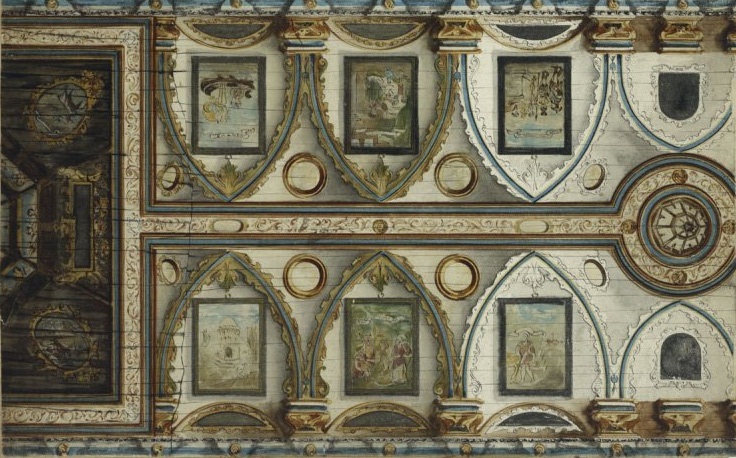
When
Charles II came to Scotland, the 3rd Earl of Winton waited
on him and had continued with his Majesty till November
1650, when he went home in order to prepare for the
solemnity of the Coronation, but died Dec. 17 following,
aged 65, and was buried at Seton; leaving his title to his
eldest son's own son, George, who became 4th Earl of Winton;
and his son Alexander was created, by King Charles II,
Viscount Kingston in 1650.
Alexander, younger of Seton, had
at the age of twelve the honour of welcoming King Charles at
Seton in 1633 with a Latin Oration, and whereby he was then
knighted on the spot. The account of this ceremony may here
be appropriately quoted, because it must have been very
similar to the manner in which King James was received with
Latin Speeches, at the houses of the Scotch nobility, but of
which we have no so particular narration.
At the iron-gate of Seton,
his Majesty sat in state with the Nobility sitting around
him, when the young Nobleman advanced, " being attended with
his Schoolmaster, a pedagogue, and four other Masters of
Arts, all grave and learned men, clothed in black cloth and
cloaks lined through with velvet, the ground being covered a
great way from the throne with a carpet, when he did deliver
his Oration boldly, with a gesture suitable to the
purpose, for which he had the applause of his Majesty and
all present; and before he rose off his knee, his Majesty
did him the honour to confer the honour of Knighthood on
him, and said to him:
'Now, Sir Alexander, see that this
does not spoil your school; by the appearance, you will be a
scholar.' Sir Alexander boldly answered: 'No, please your
Majesty, it will not." After this he returned to school, and
studied with more alacrity and assiduity than formerly, by
reason of his promise to the King."
The Palace was held for a short
time in 1715 by Brigadier Macintosh and a detachment of
Highlanders before their march to the Borders to join the
Northumbrian insurgents under Mr. Forster and Lord Derwentwater
during the Jacobite Rebellion, in which event the 5th Earl of
Winton was forfeit for his participation, and thus ending the Seton
tenure in East Lothian. | 